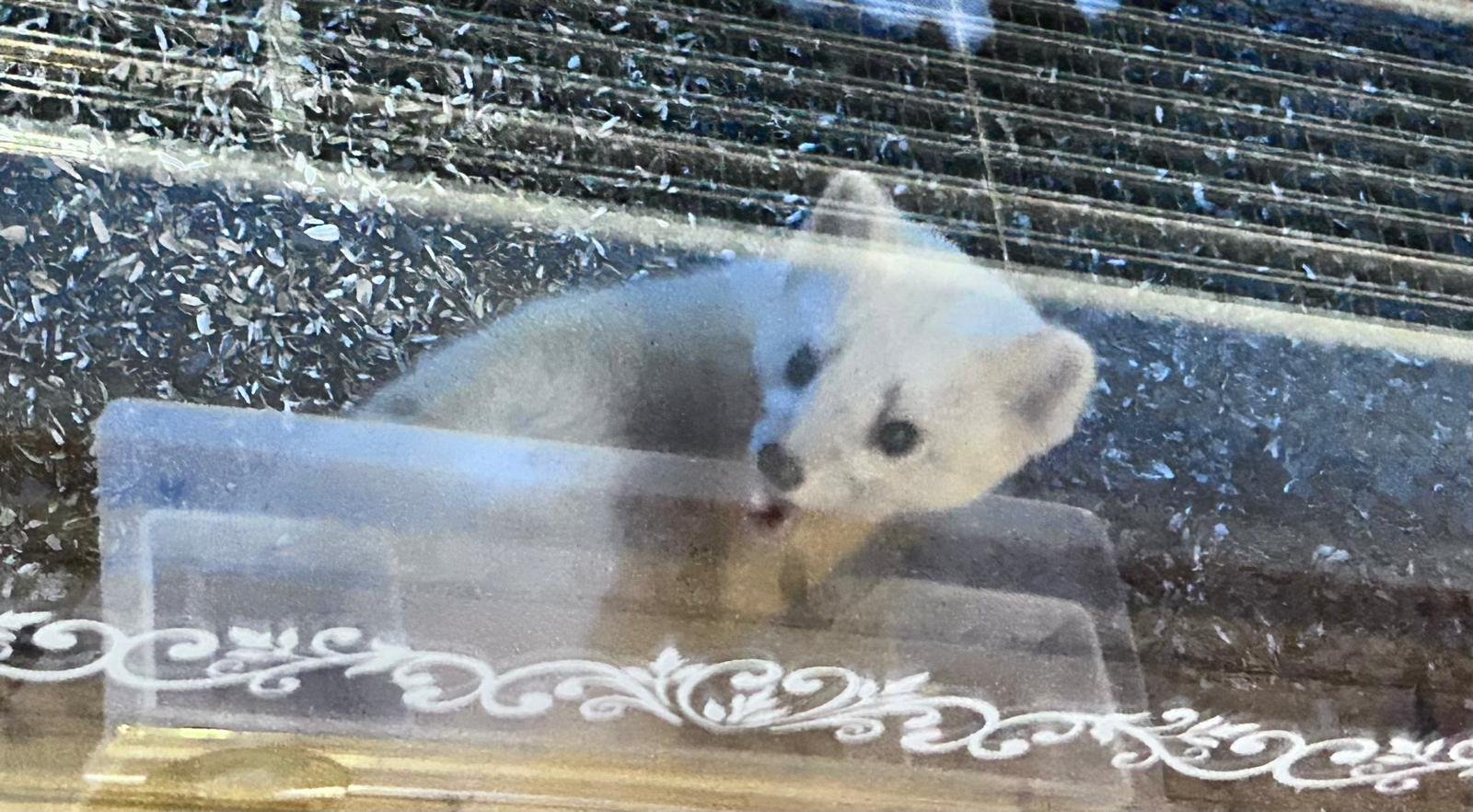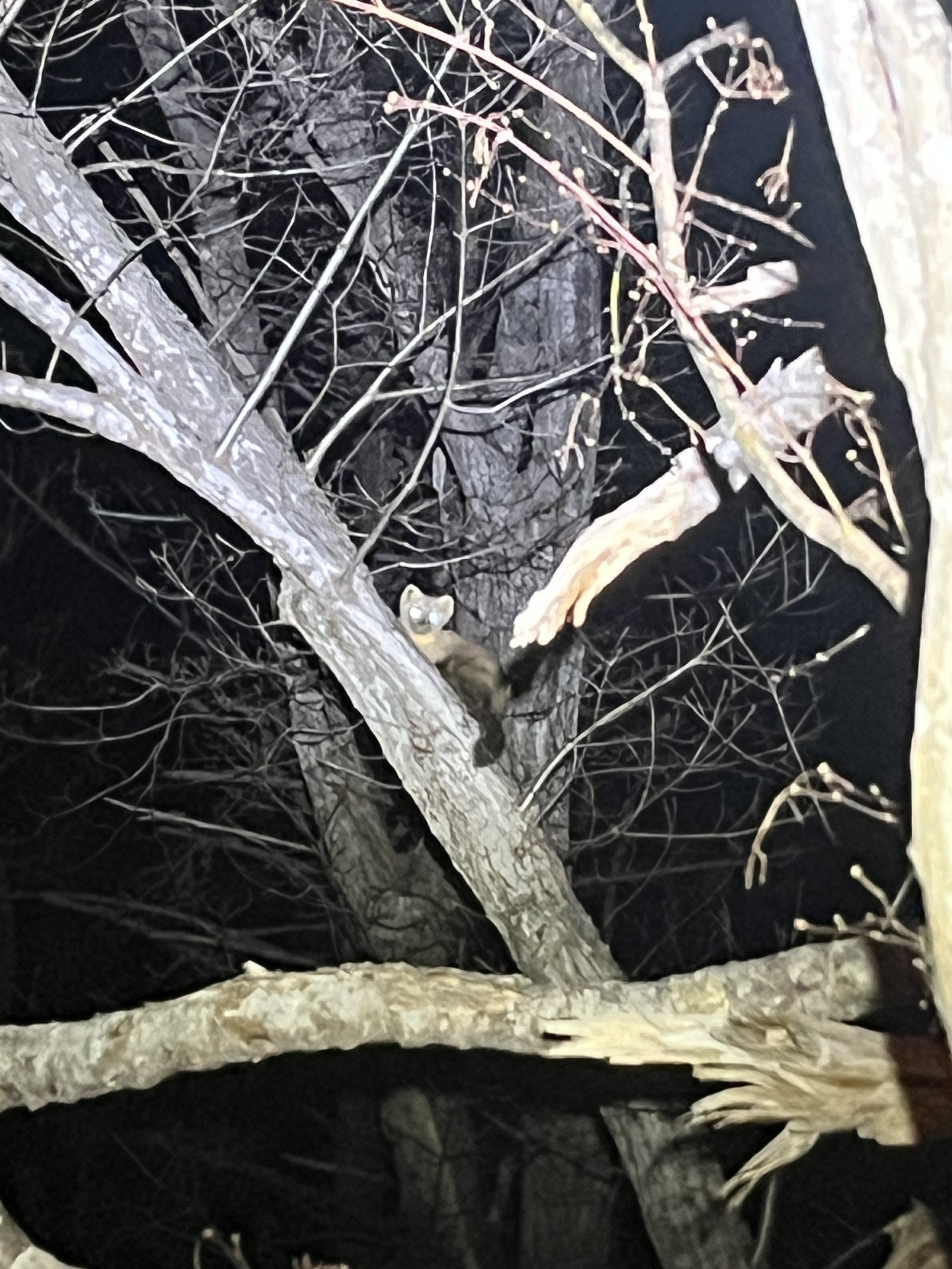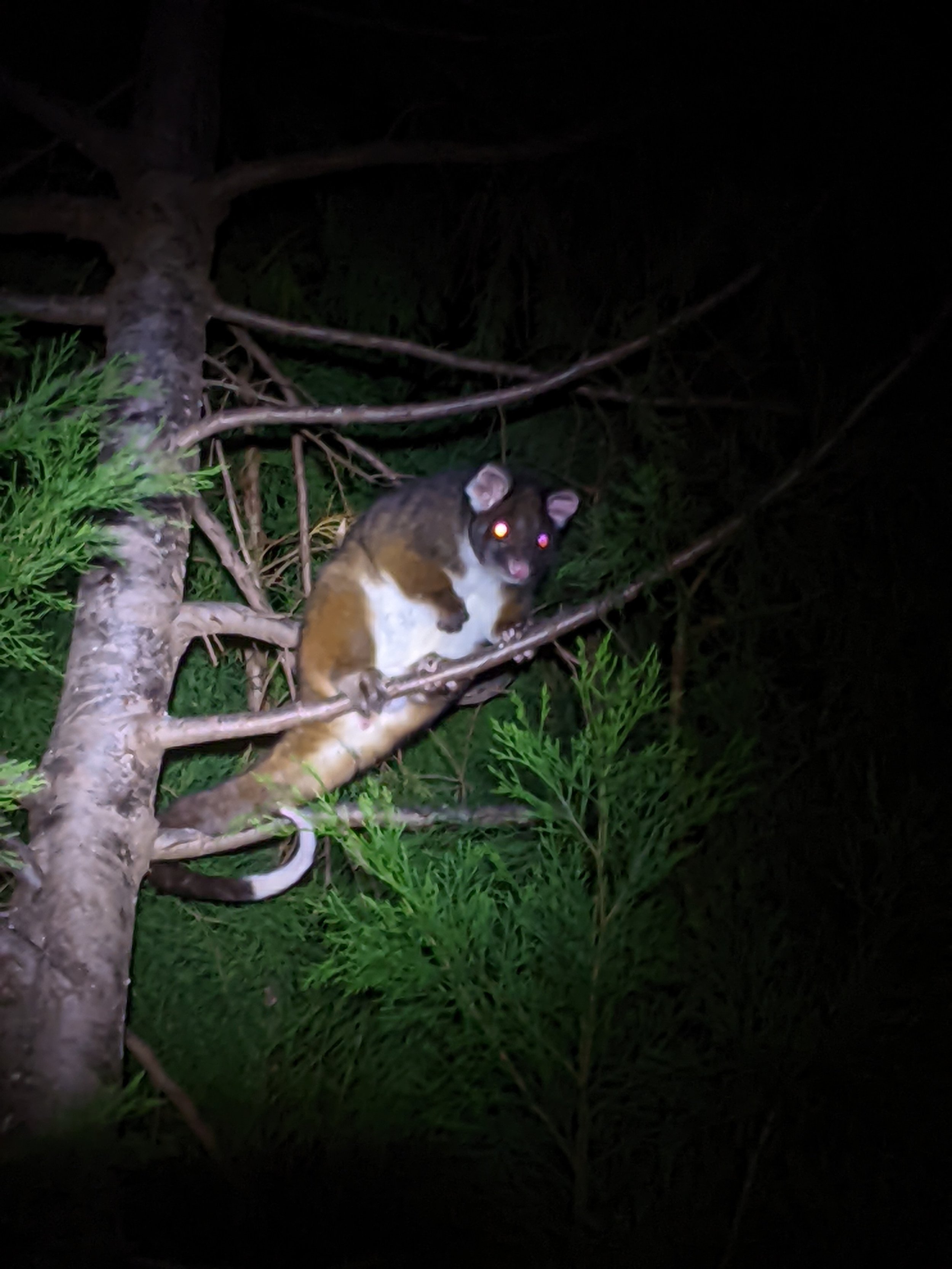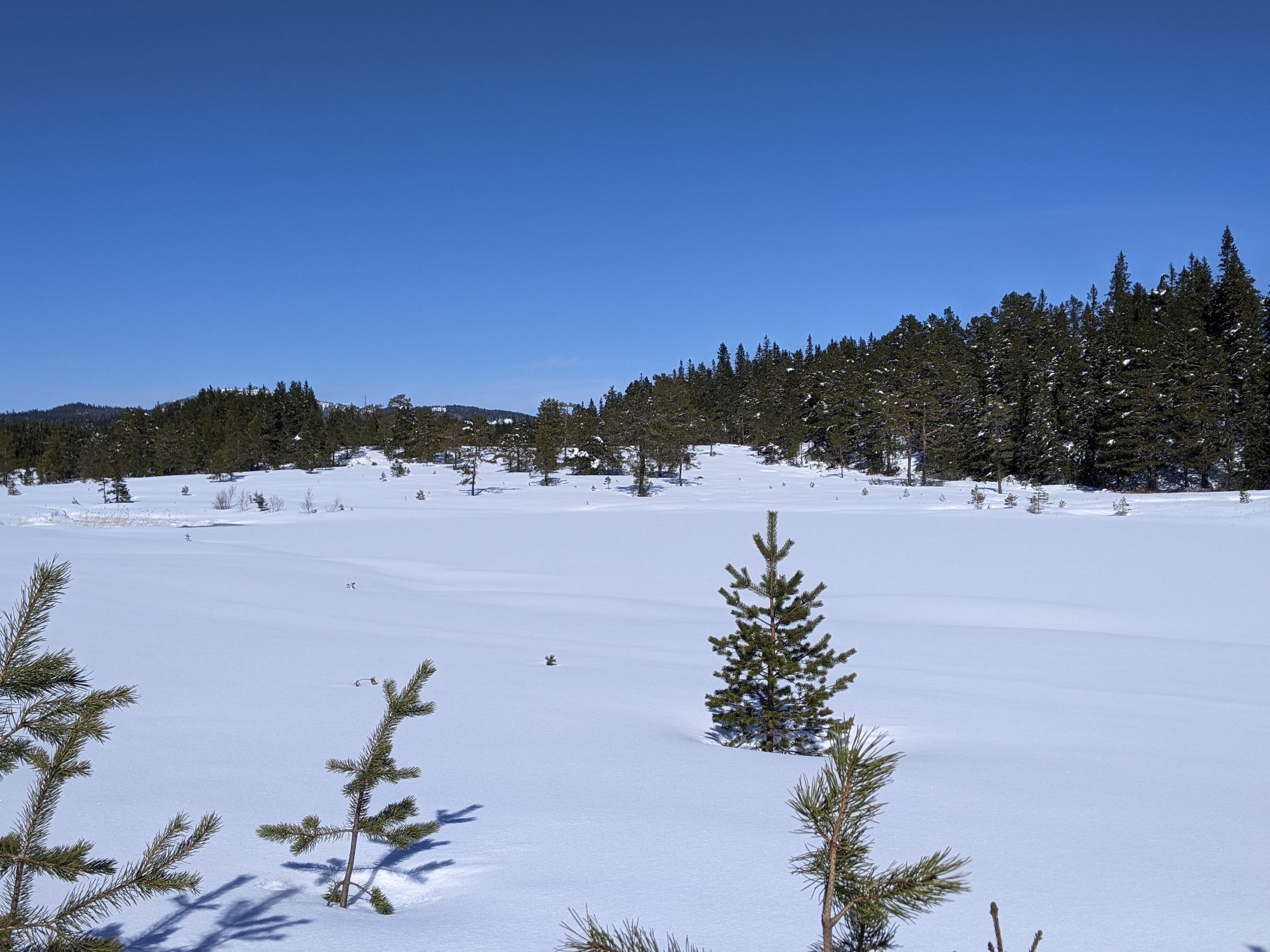First, it is worth visiting Grande Terre just for the plants. I am no expert in plants but New Caledonia is home to the most amazing and otherworldly-looking forests I’ve ever seen. Some of the trees look unlike anything I have ever seen before, anywhere. Others are unique, weird things that are common in botanical gardens around the world, but disorienting to see growing wild all over the place. Still others look exactly like the white pines of my Ontario, Canada homeland, which is totally disorienting on a tropical island off the east coast of Australia. It’s a strange overall sensation when it looks and smells like I’m hiking in Georgian Bay, Ontario, while Australian birds like lorikeets and honeyeaters are screeching around me. Should I be looking out for brown snakes (Pseudonaja sp.), the huge, deadly, intimidating Australians or for brown snakes (Storeria dekayi) the diminutive, shy, inoffensive Canadians? My brain had trouble computing. Luckily (?) Grande Terre is an island with no land snakes at all.
It’s not just the trees, either. In New Caledonia, roadside ditches can be filled with Neopenthes vieillardii, a species of pitcher plant that grows its deep red pitchers from the tips of its leaves. The nicest looking miniature ferns in the world, the ones that are commonly sold as terrarium plants because they evoke a tropical rainforest all on their own, are endemic to New Caledonia. Other, larger fern species produce bright pink fronds. The small plants of New Caledonia are specitacular; I haven’t even mentioned the orchids!
However, I am not a plant-chaser, I am an animal-chaser. And New Caledonia has some excellent animals.
Mammals
Land mammals on Grande Terre are limited to four species of fruit bat, four species of insectivorous bat, and a grab-bag of the usual invasive mammals.
Fruit Bats The four species of fruit bat consist of three species of flying fox (Pteropus ornatus, P. tonganus, and P. vetula) and one species of blossom bat (Notopteris neocaledonicus). The two larger species of flying fox, the ornate (P. ornatus) and Pacific (P. tonganus) are relatively common while the two smaller species, the New Caledonian flying fox (P. vetula) and blossom bat (N. neocaledonicus), are rare, local, and poorly known. Three are endemic; the insular flying fox is widespread across the Pacific.
Even the two relatively common species are, however, hard to find. Apparently because they’ve been hunted up until recently, flying foxes in New Caledonia are not like flying foxes in Australia. They go to great efforts to avoid humans and are hard to find even in protected areas. I never saw a single flying fox, even just flying overhead, anywhere except one place, where, fortunately, they were extremely easy to see.
That location would be Les Roches de Lindéralique, and, in particular, this picnic/camping spot with a lookout over the rocks. The karst rock formation itself is otherworldly and worth the trip on its own. During the day, scanning the trees perched on the rocks through my binoculars from the lookout, I couldn’t make out a single flying fox roosting anywhere. They must really be good at concealing themselves, however, because come dusk the trees were full of screeching foxes and the skies above the rocks were swirling with a huge flock (?) of them circling overhead. As it got almost too dark to see the foxes started streaming away from the rocks, across the lake, directly over my head, and on into the mountain forests in the centre of the island. It was awe-inspiring to see.
Les Roches de Linéralique is such a great spot not just because of the number of bats, but because of the diversity. All four species of fruit bat occur there. The three species of flying fox can be tricky to pick out just because of the distance and the light conditions. I would highly recommend going with a good scope if possible. I only had binoculars, unfortunately, and it created quite a challenging situation. The insular flying fox, large and overall dark with a pale orange patch on its upper back (scapular area), seemed to be the most common. With some patience, I started to be able to pick out the the ornate flying foxes from among them. They were slightly larger than the insulars, with an overall orangy-brown colour and a larger, paler, more poorly defined pale patch on their backs. The New Cals were the hardest. They’re significantly smaller than the other two, but they are totally dark without any defining markings. At such a great distance, and with only binoculars, I was unable to convince myself that any particular bat I was looking at was a New Cal before I lost it amongst the chaos.
Luckily there were some fruiting trees around. Two mango trees in the camping area were full of mangoes, but the bats were so shy that they would take off as soon as they realized I was there, well before I was able to get my light on one and see what kind it was. Luckily there were some fruiting fig trees along the Route de Lindéralique, the road that goes behind the rocks (inbetween the rocks and the ocean). Driving slowly along this road with my windows down, I was able to find some food trees by listening for squabbling foxes, and here, with some patience, I finally was able to pick out all three species of flying fox.
I believe Les Roches de Lindéralique is one of only a few known roosting sites for the blossom bat, a very rare animal. They aren’t easy to see, either. Broadly speaking, they look like teeny weeny flying foxes, but once you get used to them they are quite different. For starters their fur is much paler and doesn’t have the reddish tones of the foxes. They also have a long, membrane-free, mouse-like tail, which is very distinctive considering the flying foxes are all tailless. I was extremely lucky to see one blossom bat. I was standing at the lookout over the water, watching bats stream towards me, and I saw one that was flying much, much lower than all the rest, and was tiny by comparison. I got my light on it for a split second as it went over my head - a blossom bat!
There is one other place to mention for flying foxes, Ile Nemou (AKA Nemu Island). Although I didn’t make it there, there is apparently an approachable camp of ornate and Pacific flying foxes on this island.
Insectivorous Bats There are four species of insectivorous bats on Grande Terre, I believe: New Caledonian Wattled Bat (Chalinolobus neocaledonicus), Little Long-fingered Bat (Miniopterus australis), Small Melanesian Long-fingered Bat (Miniopterus macroneme) and New Caledonian Long-eared Bat (Nyctophilus nebulosus). I certainly saw insectivorous bats in several locations, including Mt Koghis and Parc provincial de la Rivière Bleue (Blue River Provincial Park), but I am not experienced enough to identify them. I did record them on my Anabat Bat Detector, though. If anyone has experience with these things and wants to help me analyze the recordings, I would certainly be very much obliged!
Introduced Mammals The only non-bat terrestrial mammals in New Caledonia are humans and species introduced by humans. The deer, Javan rusa deer (Rusa timorensis), are relatively common and always seem to be around at night, which is unfortunate because they make the most hideous ungodly scream when they are alarmed, for example by a man shining a headtorch in the forest. Even more unfortunately, domestic cats can be positively abundant. I sometimes saw upwards of 5 wandering around at night in what were supposed to be relatively wild locations. Brown rats (Rattus rattus) were common in the more anthropogenic areas, while Polynesian rats (Rattus exulans) were common in more natural areas. The Polynesian rats also seem to be a lot more arboreal and I saw them particularly in fruiting trees and coconut trees.
Birds
My full bird list from the trip is here.
Kagu The kagu is the most desirable bird to see for the vast majority of birders headed to New Caledonia, I think, because it is so unique and weird. Luckily for me they were very easy to see in Parc Provinciale de la Riviere Bleu. The key Kagu area is along the main road through the Blue River section of the park between the Sentier des Cagous (Kagu Trail) and the Pont Germain (Germain Bridge). This is the wettest forest in the park (at least that I’m aware of) and it seems to be full of Kagu. There were three tame individuals who regularly came through the camp site at Pont Germain and another two that followed me along the Grand Kaori Trail. I also saw several shyer individuals just walking along the main road.
They are also apparently present in Parc Provinciale des Grandes Fougères, but I didn’t look for them there.
Crow Honeyeater Although the kagu is almost certainly the most desirable bird for those who are new to Grande Terre, the crow honeyeater maybe the most desirable for those familiar with the island. The crow honeyeater is huge, among the largest honeyeaters in the world, and jet-black with some deep red markings on their facial skin. I’d heard that there was a flowering tree the crow honeyeaters liked to feed on at Gué de la Pourina, however when I got there I found a couple sitting on a bench opposite the tree in question who told me they had been watching the tree every day, 4-7 hours a day, starting at dawn, for the past four days and they hadn’t seen the crow honeyeater. The tree also looked like it was pretty much done flowering. So I gave up on that idea. I also tried to find them by call, but I could not distinguish recordings of their call from the angry calls of New Caledonian friarbirds, and so I gave up on that as well.
The same couple told me something interesting, that the crow honeyeater is partially nocturnal, and that they had heard one calling from their campsite from 3am. They had been camping at Aire du Dacrydium, just over the bridge from my campsite at Pont Germain. The evening after they left, I went to Aire du Dacrydium and staked it out. A crow honeyeater flew in right at dusk when the light was just about totally gone, and it disappeared quickly into the forest. I never heard it, and I couldn’t find it again.
I was very lucky to see a another crow honeyeater as one flew across the main road while I was waiting for the bus out of the park. I was at the bus stop at turn off for the Grand Kaori walking track. I got a better look at this one - it was the middle of the day - but it also disappeared rapidly into the forest and I couldn’t refind it. They seem to move quicky and silently through the midstory and low canopy of the forest. A challenging bird to see!
Striated Starling I thought starlings would be easy to find but I didn’t come across these very often. I first saw them in an open area near the start of the Sentiere des roches de la Ouaième near Hienghene, then on power lines on the side of the road on the drive up to the Grottes du Koumac.
Metallic Pigeon I saw them twice. First was on some power lines along the road near the start of the Sentiere des roches de la Ouaième hike, and then again I saw them at the plateau at the entrance to the Parc Provinciale des Grandes Fougères.
Red-bellied Fruit-dove I only saw one once, when one popped out of the brush at a spot I had seen two long-tailed trillers fly into the brush while I was driving. My impression is that they aren’t as easy to see on Grande Terre as they are elsewhere in their range.
Cloven-feathered Fruit-dove These are supposed to be common, but I struggled to find them, maybe just because they are hard to spot. I didn’t see any in the provincial parks. I only saw one individual, and it was at Grottes du Koumac.
New Caledonian Imperial-pigeon These I found relatively easily. I saw huge numbers along Sentier La Source in Parc Provinciale de la Riviere Bleu and smaller numbers elsewhere in the park. I also saw them at Sentiere des roches de la Ouaième, Parc Provinciale des Grandes Fougères, Grottes du Koumac, and Site a ménage de Nehoue.
New Caledonian Parakeet I believe these are what the locals call the mountain parakeet, but I’m not sure. I only saw them once, at dawn, along the main road through Parc Provinciale de la Riviere Bleu at the turnoff for Aire du Dacrydium. The couple who had been camping at Aire du Dacrydium said they saw these birds around the campsite daily in the morning and the evening.
Horned Parakeet I saw one individual mixed in with the flock of New Caledonian Parakeets in Parc Provinciale de la Riviere Bleu, and I saw another one at Grottes du Koumac.
New Caledonian Myzomela These didn’t seem too common, although I did find them in a few places, including the rainforest part of Parc Provinciale de la Riviere Bleu, along the main road just before the turnoff to Port Boisé Camping, the lookout over Les Roches de Lindéralique, the Sentiere des roches de la Ouaième, and the Site a ménage de Nehoue.
Barred Honeyeater Again, these were surprisingly uncommon. I didn’t find any in the rainforest area Parc Provinciale de la Riviere Bleu, although I did see some near the petroglyphs. I also saw them at a lookout over Noumea on the way up to Mt Koghis, at the Chutes de Madeleine, at the Site a ménage de Nehoue, and on the plateau where the entrance to the Parc Provinciale des Grandes Fougères is. These are all relatively dry forest or scrub spots, which I didn’t expect.
Dark-brown Honeyeater These are probably the bird I saw the most of. They are just about anywhere there is vegetation, including in city parks in Noumea.
New Caledonian Friarbird Common birds anywhere there is forest or high scrub; I think they were most common in the rainforest. But that might just be my impression because they do a frustratingly accurate impression of a crow honeyeater call when they are squabbling with each other, which they do a lot. And I was searching desperately for a crow honeyeater in the rainforest section of Parc Provinciale de la Riviere Bleu.
South Melanesian Cuckooshrike These are the easier of the two cuckooshrikes to find. I found them in dry scrub habitat, usually as one flew across the road as I was driving. Watch for them flying low and hawk-like, they were usually pretty easy to find sitting on a branch in the scrub near where I saw them fly across.
New Caledonian Crow Surprisingly common, given that I got the impression from previous trip reports that they were rather rare. Granted, I only saw them once in Parc Provinciale de la Riviere Bleu, including one individual using a twig as a foraging tool (!), but I saw them many other places, including randomly along roadsides as I was driving. Seem to prefer tall forests, I think.
New Caledonian Grassbird I only saw them at the Sentiere des roches de la Ouaième, on the first part of the trail where the habitat is overgrown grasses, but they seemed to be pretty common there. I even saw one right at the start of the trail in grass along the roadside!
Red-throated Parrot-finch I saw them very well at Grottes du Koumac, both in the tent area (to the left after you pass the entry gate) where there is very short grass and it is quite open under some canopy trees, and on the fencing and old farm equipment of the ranch that you pass on the left just before entering Les Grottes du Koumac. I also saw one briefly on the plateau at the entrance of Parc Provinciale des Grandes Fougères.
Reptiles
New Caledonia has what I think are the world’s most spectacular geckos. They’re a smaller group (~10 species) of soft-skinned, huge-eyed, monstrously large geckos. Unfortunately, they are also very attractive and become quite tame in captivity, and so are highly desirable in the international pet trade. One species, the crested gecko (Correlophus ciliatus) makes such a good pet that it is a strong contender for the world’s most bred and most sold lizard. Another, the New Caledonian giant gecko (Rhacodactylus leachianus) still regularly sells for over $1000 an animal despite being easily bred and relatively common in the pet trade. All the giant geckos of Grande Terre are represented in the pet trade to some degree and all, with the exception of crested geckos, still command high prices. Because of this unfortunate set of circumstances, smuggling is a major problem for these animals, and I won’t be sharing the locations at which I observed most reptiles in New Caledonia.
The one exception is Parc Provinciale de la Riviere Bleu. It is heavily touristed, does not allow private vehicles (you have to take their shuttle bus in and out), and is regularly patrolled by rangers who are cognizant of the smuggling problem, so I will share my herping advice for this park. I was there at the very end of December, and at the start of the rains (which were late, apparently they usually come in October), which is probably the best time for herping. It was really hot, and really humid.
At dusk one night I walked east along the “old road”, a very rough road (for driving, it’s fine for walking) along the north bank of the Blue River, starting from the Pont de Germain (where I was camping) to the Gué de la Pourina, where I waded across the river (“Gué” is “ford” in French) to the south bank to meet the main road, which runs along the south bank of the river. I then walked west along the main road back to the Pont de Germain, my campsite. Along this not-so-large loop I managed to see all but one of the giant geckos present in the south of Grande Terre: crested gecko (Correlophus ciliatus), New Caledonian giant gecko (Rhacodactylus leachianus), gargoyle gecko (Rhacodactylus auriculatus), Correlophus sarasinorum and Mniarogekko chahoua. Over the three days I spent in Parc Provinciale de la Riviere Bleu I also found several skink species: Caledoniscincus festivus, Caledoniscincus austrocaledonicus, Tropidoscincus variabilis, Caledoniscincus notialis, and Epibator nigrofasciolatus, as well as one additional gecko species, Bavayia septuiclavis.
There are a few other herping suggestions I have for Grande Terre, involving herps that are not at risk of poaching. First, the ruins of Port Boise, a former prison/hard labour camp, are covered in the endemic New Caledonian Snake-eyed Skink (Cryptoblepharus novocaledonicus). This skink is supposedly also found on rocky shorelines, but the Port Boise ruins were the only place I saw them.
The picnic/lookout/camping spot at Les Roches de Lindéralique had both Lepidodactylus lugubris and Hemidactylus garnotii, two gecko species that occur worldwide because they’ve been repeatedly introduced by humans. For anyone looking for them in their native habitat, they are actually (most likely) native, not introduced, in New Caledonia. Elsewhere I could only turn up the introduced Hemidactylus frenatus.
Finally, for anyone looking for sea snakes and sea kraits, Baie des Citrons in Noumea has incredible densities. I snorkeled all day in the bay, both inside and outside of the shark net, and found maybe 20-30 turtle-headed sea snakes (Emydocephalus annulatus) in that time. The density was just incredible. I also found one other, an olive-headed sea snake (Aipysurus laevis). In the evening, walking along the rocks below the rock wall that forms the southern boundary of the bay, I found dozens of black-lipped sea kraits (Laticauda laticaudata). I also found a green sea turtle and a hawksbill sea turtle, but both were inside the shark net so I think they would be captive, not wild.
Amphibians
There are no native amphibian species on Grande Terre and only two introduced ones. Of those two, I only saw the green-and-gold bell frog (Litoria aurea). I saw (and heard) a few calling from the river below Pont Germain in Parc Provinciale de la Riviere Bleu but they did not seem common in the park. They were very common, however, at the Site a ménage de Nehoue in the far north.
Things I missed
New Caledonian Goshawk I was told these goshawks are sparsely distributed and difficult to target, and indeed I did not come across one in my ten days wandering around the island. One of the best places, I was told, was the drive up to the entrance of Parc Provinciale des Grandes Fougères, and I drove this road a few times, but I didn’t manage to spot one.
3/4 of the Eurydactylodes gecko species. Despite intensive searching in several places from where they’re known, I saw hardly any of the very weird and spectacular Eurydactylodes. There was one night where I managed to turn up a couple of Eurydactylodes agricolae, though, so I wasn’t completely shut out.
New Caledonian Sea Krait (Laticauda saintgironsi). Other people report finding extremely high densities of these, and there are far more reports of them on iNaturalist than the black-lipped sea kraits. I saw dozens of sea kraits around Noumea but every single one was a black-lipped. Maybe the New Caledonian sea kraits have a preference for small islands? I don’t know, I was confounded by my inability to find what lots of tourists seem to come across accidentally.
Sea snakes that weren’t turtle-headed. iNaturalist lists eight species of sea snake in addition to the turtle-headed sea snakes as being present in the Baie des Citrons. I bet with a couple more days of snorkeling I could have turned a few of them up.
















